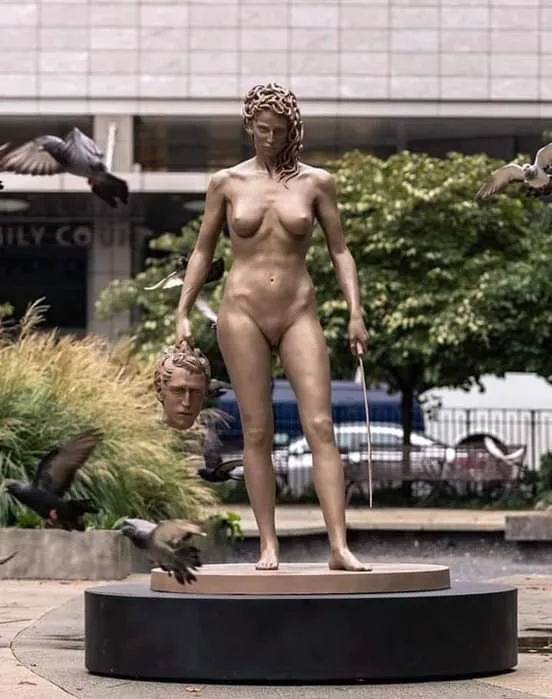Statues and sculptures have long been a medium for storytelling, often immortalizing historical and mythological figures in ways that reflect cultural values. One such statue that has sparked discussions on mythology, feminism, and justice is Medusa with the Head of Perseus, a modern reinterpretation of Greek mythology by artist Luciano Garbati. Unlike traditional depictions, where Perseus is the victorious hero holding Medusa’s severed head, this statue reverses the narrative—portraying Medusa as the one standing victorious.
The Myth of Medusa and Perseus
Medusa is one of the most recognizable figures in Greek mythology. She was originally a beautiful woman who, according to some versions of the myth, was raped by the sea god Poseidon inside the temple of Athena. As punishment, Athena transformed Medusa into a Gorgon, a creature with snakes for hair and a gaze that turned people to stone. Perseus, a demigod and son of Zeus, was later tasked with beheading Medusa and successfully did so with the help of divine weapons. He used her head as a weapon before eventually giving it to Athena, who placed it on her shield.
The Artistic Reinterpretation
Luciano Garbati, an Argentine-Italian sculptor, created Medusa with the Head of Perseus as a direct inversion of this classical myth. The statue features a nude Medusa standing tall, holding Perseus’ severed head in one hand and a sword in the other. Her expression is calm yet determined, in stark contrast to the typical monstrous or victimized portrayals of Medusa in historical art.

This sculpture is often seen as a response to Benvenuto Cellini’s 16th-century statue Perseus with the Head of Medusa, which depicts Perseus triumphantly holding Medusa’s severed head while standing over her defeated body. Garbati’s work challenges this narrative, asking viewers to reconsider Medusa’s role in the myth.
Symbolism and Meaning
The statue carries profound symbolic weight, particularly in the context of contemporary discussions on gender, power, and justice:
- Reversing the Narrative – Traditionally, Medusa has been portrayed as a monster, but Garbati’s sculpture presents her as a figure of strength and agency, turning the tables on her executioner.
- Feminist Interpretation – Many have linked the artwork to the #MeToo movement, which seeks to empower survivors of sexual violence and challenge the impunity of perpetrators. Medusa’s myth has long been seen as a story of victim-blaming, making this statue a powerful counterstatement.
- Symbol of Justice – The statue was placed near the New York County Criminal Court in Lower Manhattan, the location of several high-profile sexual assault trials. This location further reinforces its message of justice for survivors.
- Medusa’s Gaze – Unlike in traditional stories where her gaze turns others to stone, Garbati’s Medusa does not appear to be using her power violently. Instead, she stands with an air of quiet defiance, suggesting strength rather than revenge.
Public Reception and Controversy
The statue has received both praise and criticism. Supporters see it as a necessary re-examination of historical narratives that have often villainized women. However, some critics argue that depicting Medusa holding a severed head promotes a form of retributive justice rather than true empowerment. Others have pointed out that the statue, designed by a male artist, might not fully capture the female perspective on the myth.
Conclusion
Medusa with the Head of Perseus is more than just a statue; it is a statement on power, justice, and gender dynamics. By reimagining Medusa not as a monster but as a figure of resilience, Garbati’s work challenges viewers to question long-standing myths and their implications in today’s world. Whether seen as an artistic masterpiece, a feminist symbol, or a controversial reimagining, the statue undeniably provokes thought and discussion, proving that mythology is still relevant in shaping contemporary discourse.











